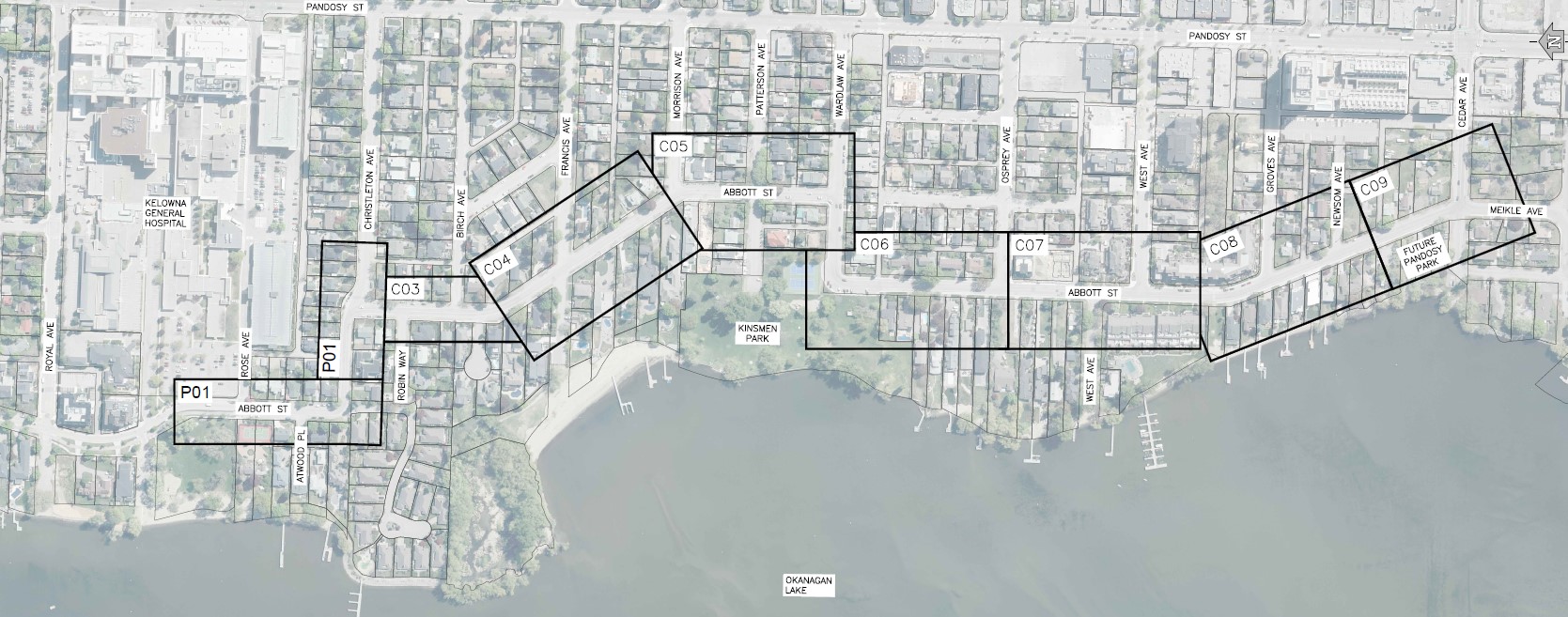Abbott ATC Evaluation
Thank you to those who provided feedback on the quick-build portion of the Abbott ATC between Christleton and Cedar Avenue. The City was looking to understand how it is performing, and how to implement more quick-builds around Kelowna in the future. The engagement summary is now available with what we heard from you! Check it out here, or in the Documents tab on the right side of this page.
What is a quick-build project?
This quick-build pilot project used semi-permanent materials on the roadway to create protected space for biking and walking. Some materials can include concrete barriers, planters, flexible posts and/or reallocating existing road width/pavement for protected bike lanes. The approach on Abbott allowed us to fill this gap in the active transportation network faster and cheaper than conventional methods and it can be used elsewhere in the city.
What is an ultimate-build project?
Ultimate-builds can include full urbanization of the road such as paving the full width of the road, upgrading the drainage infrastructure, adding concrete curb & gutter, protected bike lanes with concrete median/curb, boulevards with trees/vegetation, new concrete sidewalk and curb letdowns.
Get Involved - closed
Between October 12 and November 5, participants are invited to:
- Complete the 10-minute survey
- Place a pin on the interactive map identifying any strengths, challenges and opportunities along the route
Survey - closed
Map
Video - Abbott Active Transportation Corridor Before and After
More project information
Ultimate build construction:
- Completed between Rose and Christleton avenues, similar to the existing Abbott Street corridor to the north.
- 200 metres of bi-directional protected bike lanes were added, with sidewalks on both sides of the road and parking maintained on one side near Rose Ave.
- Landscaped boulevards, lighting and upgrades to the existing 3-way intersection at Christleton and Abbott avenues were also incorporated as part of the ultimate build.
Quick build construction:
- Completed the gap to continue the corridor between Christleton to Cedar avenues.
- 1200 metres of protected bike lanes were added to the existing asphalt using concrete barriers and planter boxes as a physical buffer between vehicles and cyclists.
- The project also included pedestrian and accessibility improvements such as crosswalks, curb letdowns, and asphalt fillets at key locations.

View updated detailed design drawings in more detail here.
 Abbott Street is one of Kelowna's busiest bicycling and pedestrian routes.
Abbott Street is one of Kelowna's busiest bicycling and pedestrian routes.
Upgrades will create a safer and more comfortable bicycling route for people of all ages and abilities.
We've piloted quick-build infrastructure to extend the Abbott ATC sooner than ultimate infrastructure could be funded (2030 or later).
Quick-build strategies combine interim materials within existing street space with limited new construction to deliver projects faster and at a lower cost.
Ultimate and Quick-Build Infrastructure
The 2021/2022 Abbott Protected bike lane project achieved bi-directional bike lanes separated from pedestrians and vehicles between Rose Ave and Cedar Ave. It used a combination of ultimate and quick-build infrastructure and was recently completed in fall 2022.
Traffic Calming
Speed data previously collected shows that average speeds along the corridor are between 30 – 40 kph. With the addition of protected bike lanes, narrower travel lanes, improved pedestrian crossings, and other active transportation enhancements, average vehicle speeds are anticipated to decrease. With the project complete, speed data is being collected for a before/after comparison.
Sidewalk Network and Accessibility
Although the Abbott Protected Bike Lane project is focused on cycling facilities, the sidewalk network in the area is an essential component of the ATC project and Neighbourhoods. Through public engagement, we heard a strong need for accessibility improvements along the corridor.
Pedestrian improvements include but are not limited to, curb letdowns (where applicable), six Zebra crosswalks (at appropriate locations) and the extension of the sidewalk between Rose and Christleton, which fills a critical missing link in the sidewalk network. With this gap filled, a continuous sidewalk spans from one end of the project to the other.
Wayfinding
Now that the protected bike lanes are constructed, the route has become clearer. Pavement markings are another key tool to avoid the mixing of peds/bikes with clear direction and separation of users.
On-Street Parking
The project aimed to retain as much parking as feasibly possible. Suitable locations for accessible reserved spaces were also explored as part of the detailed design process and a space was added at Kinsmen Park.
Parking utilization data was collected before and after the project. The results will be part of the overall project evaluation.
Barrier Type
One common reason for choosing ‘planter box’ and ‘concrete curb’ barriers included a perceived higher level of safety as they provide good physical separation, which provides a higher level of comfort. Reasons provided in the comments section for choosing the 'concrete curb barrier' type also included lower cost and reusability.
Balancing cost, aesthetics, safety, and reusability also aligns with the City's desire for a material that is easy to maintain, reusable, and cost-effective. For those reasons, a combination of concrete curb barriers and planter boxes at key locations were selected for the quick-build portion of the project. Both materials offer reusability, strong traffic separation, and have an aesthetic quality in most cases.
Maintenance
Routine cycle track maintenance will be performed similarly to other ATCs in the city. Planter boxes require additional maintenance.
Previous Engagement (2021)
Survey
Abbott ATC preliminary design & quick-build infrastructure
CLOSED: This survey has concluded.
Project Details & Updates
Previous FAQs
Q&A
Ask a question
To ask a question you must create an account or log in.
These are the people that are listening and responding to your questions.
Respondent 1
Respondent 2
{{question.description}}









